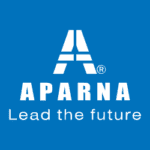Category: Media
Ready-Mix Concrete Advancing Sustainable Construction
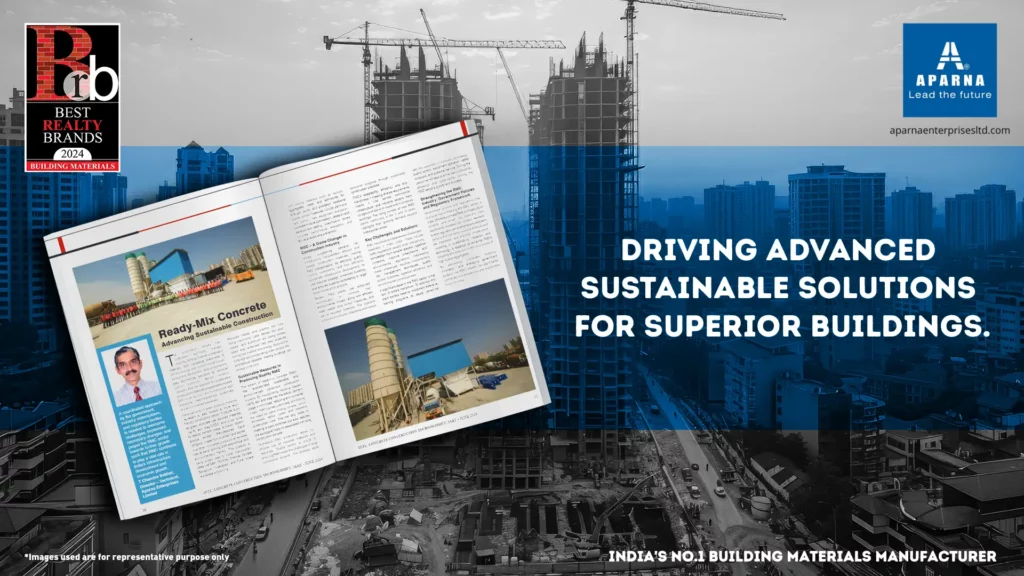
A coordinated approach by the government, industry stakeholders, and regulatory bodies is needed to overcome challenges, implement necessary changes, and propel the RMC sector towards further growth such that RMC continues to play a vital role in India’s infrastructure development and economic growth.
T Chandra Sekhar, Director-Technical, Aparna Enterprises Limited
The construction industry has undergone significant changes recently, shifting towards sustainable materials. With increasing awareness of climate change and environmental issues, consumers, developers, and policymakers seek eco-friendly solutions to minimise carbon footprints. Market research indicates that the demand for sustainable construction materials is expected to exceed $365 billion by 2027 due to enhanced legal provisions, health-conscious customers, and environmental awareness.
Advancements in green building materials represent a leap toward a more eco-friendly construction sector. Products such as green concrete use recycled materials like fly ash, slag/GGBS, and silica fume to reduce cement usage, a known carbon dioxide emitter. Manufactured Sand (M-Sand), made from crushed hard stones, is another innovative product that replaces natural sand, proving both economical and environmentally friendly. This product is being widely used in Indian metropolitan cities like Delhi, Mumbai, Chennai, Kolkata, Bangalore, Hyderabad, and Pune, where real estate is booming
Recycled metals and plastics are now being commonly used. Metals like steel, copper, and aluminium are being melted down and re-formed into new products, saving raw materials and energy. Solar-active buildings are incorporating solar panels into architectural facades, making buildings net energy producers.
Sustainable Measures in Producing Quality RMC
The advent of ready-mix concrete (RMC) has revolutionised sustainable and environmentally conscious construction projects. By incorporating industrial wastes like fly ash and slag into the blend, cement usage is minimized, reducing environmental impact. RMC comes pre-mixed, eliminating the need for extra mixing on-site, which decreases labour costs and shortens construction time. This not only helps in meeting project timelines but also reduces the ecological footprint associated with long construction periods.
Centralised RMC production allows for the efficient use of recycled materials and resources. Quality control is crucial to ensuring RMC meets the challenges of large commercial projects. The process starts with testing materials such as cement, aggregates, water, and admixtures for strength, purity, and gradation. Additional quality control measures include plant and field control, new equipment evaluation, concrete mixture optimisation, research and development testing, specification review, concrete performance evaluation, and failure analysis and prevention.
RMC – A Game Changer in Construction Industry
India’s burgeoning demand for infrastructure necessitates efficient and reliable construction materials, making RMC indispensable. Its efficiency, quality control, consistency, and time efficiency accelerate infrastructure development. Its use reduces wastage, enhances durability, and ensures superior consistency in large-scale construction projects.
Modern RMC plants use advanced technologies to minimise their environmental impact, along with efficient water usage, dust control measures, and the use of recycled materials. This supports India’s environmental objectives and fosters economic progress through sustainable construction practices.
RMC’s adaptability, efficiency, and eco-friendliness in meeting diverse requirements make it vital across commercial, infrastructure, and industrial sectors, from bridges and dams to roads and multi-storey buildings. The rising number of new RMC plants, particularly in tier II and III cities, highlights their growing demand beyond metropolitan areas.
Key Challenges and Solutions
RMC manufacturers face several challenges, especially in metro cities. These include traffic regulations, supply chain disruptions, competition from smaller players, logistical limitations, machine breakdowns, and environmental regulations. Addressing these challenges requires implementing risk management techniques, quality control practices, logistical efficiency, and environmental consciousness.
A significant issue in the RMC sector is the lack of skilled manpower. To address this, plant owners need to implement extensive training programs to equip personnel with expertise in concrete technology, quality control, equipment operation, safety protocols, and customer service. Skilling the personnel will lead to enhanced productivity, efficiency, and sustainability, driving the RMC sector’s growth and success.
Strengthening the RMC Industry: Government Policies and Regulatory Framework
Government policies and regulations play a crucial role in shaping the RMC sector in India. Efforts to promote RMC in infrastructure projects and smart city missions have significantly boosted the industry. However, further regulatory amendments are needed to simplify the framework, provide financial and tax incentives, and improve infrastructure. Investing in sustainability, research, and technology is essential to enhance RMC’s longevity and ensure a continuous supply of high-quality aggregates.
By addressing challenges, fostering innovation, and leveraging government support, the RMC industry can significantly contribute to a prosperous and sustainable future for India
Building Greener Futures With Aparna Enterprises Limited
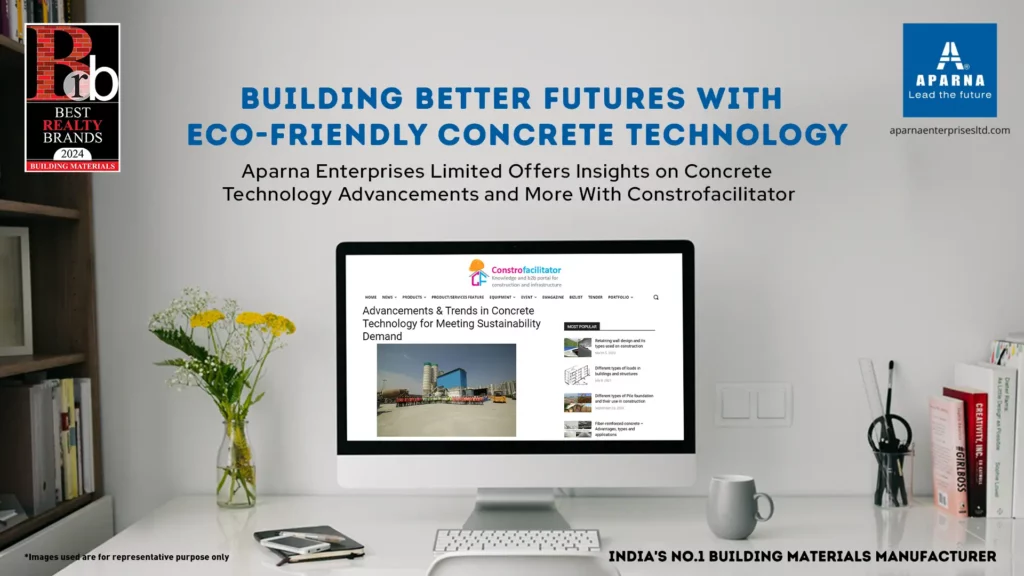
The increasing demand for concrete innovation is driven by the urgent need for sustainable solutions in construction. With urbanization and infrastructure development on the rise, there’s a pressing demand for concrete that not only meets structural requirements but also minimizes environmental impact. Innovations in concrete technology are focused on sustainability, incorporating recycled materials, reducing carbon emissions, and optimizing production processes. Meeting this demand requires a concerted effort from manufacturers to invest in research and development, prioritize sustainability, and embrace cutting-edge technologies to deliver innovative, high-quality concrete products for the future. Aparna Enterprises Ltd [AEL] is one such company manufacturing a wide spectrum of building-material products, such as RMC (ready-mix concrete), uPVC windows and doors, Floor and Wall tiles, Aluminium window and door systems and Exterior Facades, Cold Roll form products etc. Most of these products are available in pan India and international markets through an extensive dealer network which constitutes more than 350 vendor partners for different brands.
Constrofacilitator recently had an exclusive interview with Mr. Gopal Krishna is the Business Head for Aparna RMC. He is overlooking the ready-mix concrete division of the company and its business development. He is a visionary business leader with over 21 years of experience in crafting and executing strategic initiatives to drive top and bottom-line growth. His work in the construction segment, with a focus on cement and RMC, has focused on transforming businesses sustainable and profitable. He has achieved 100% growth in new business setups, revitalised underperforming regions, and implemented successful ERP/SAP projects. He has a remarkable track-record of successful rollout, management, and completion of projects by navigating complex challenges and making high-stake decisions.
During the interview, he shared insights on upcoming trends, innovations in the concrete construction industry, technological advancement, quality control measures and much more.
Here are the excerpts from the interview.
1.What do you foresee as the upcoming trends or innovations in the concrete construction industry, especially in terms of materials, technologies, or construction methods?
The dynamics of concrete construction is expected to undergo a dramatic transition as we enter a new era within the construction industry. With technological advancements, better materials, and modern construction methods, we are looking at revolutionising the realm of building materials.
The future of concrete construction will be on the back of building a sustainable and greener future. Traditional concrete has very adverse effects on the environment with CO2 emissions from concrete production accounting for about 8 percent of global emissions. However, the advent of ‘Green Concrete’ can reduce the impact on the environment compared to conventional concrete. The goal of green concrete is to utilise recyclable materials for production, produce less carbon dioxide, and consume low energy for production, resulting in durable and economical concrete vis-à-vis its conventional counterparts.
Furthermore, the concrete construction industry is undergoing a pivotal shift towards the production of innovative materials such as Smart Dynamic Concrete (SDC), a revolutionary development aimed at significantly diminishing carbon footprints in the construction process. The use of SDC reduces the carbon footprint of concrete and the construction process through the lower cement content, less energy, and lower in-place vibration requirements. SDC offers several economical and technical benefits, including faster speed of concrete placement with less labour, higher durability, lower energy consumption, as well as higher economy, ecological and ergonomic performance.
Drones are increasingly used in concrete technology and construction, with applications such as site inspections, progress monitoring, and data collection. Moreover, 3D printing is being used to make sophisticated concrete structures with a shorter turnaround time. This technology is aimed to transform how concrete is poured and cast, leading to faster, cheaper, and more precise construction method.
These trends and innovations have the potential to transform the concrete construction industry by improving efficiency, reducing costs, and enhancing project outcomes.
2.What initiatives or technologies are being explored to make cement production more environmentally sustainable?
Several initiatives and technologies are currently under exploration to enhance the environmental sustainability of cement production to mitigate the adverse effects of traditional concrete manufacturing on the environment.
The exploration of Carbon Capture technology leads the march. Innovative approaches, such as carbon capture and storage (CCS) technology, help capture CO2 emissions during cement production. CCS results in reduced greenhouse emissions associated with the cement production process by repurposing CO2 for use as concrete additive. Moreover, green concrete and smart dynamic cement are increasingly finding prominence in this bid.
3.How do you ensure the quality control of concrete throughout the production process, from raw materials to the final product?
Aparna RMC undertakes various measures to maintain quality control of concrete from production through delivery. We have 27 plants which are computerised using MCI 360 and Siemens PLCs, which guarantee accurate batching, and continuous production. Aparna RMC employs this technology that helps make custom mixes of aggregates, cement and admixtures that ensures that we remain a reliable partner in the construction industry. Additionally, we have measures to check that the concrete is of high standard so that it meets the industry standards hence, ensuring that RMC supplied at the site continues to be of high grade.
4.What recent innovations in cement technology have influenced the performance and environmental impact of concrete?
Recent innovations in cement technology have influenced the performance and environmental impact of concrete in various ways. A recent study has found that substituting 90% of the coal with Refused Derived Fuels (RDFs) results in saving around 28.6 metric tons per hour of coal, and increasing the Sewage Sludge (SS) fraction in the total heat consumption by 6% leads to a 17 kg of CO2 emission per metric ton of coal. This approach can contribute immensely in curbing the high emission rate associated with cement production. Alternative methods of mitigating the environmental effect of cement production are continuously developed by researchers, engineers, and contractor companies using other cementitious materials like fly ash, slag, and other industrial by-products. Innovative approaches, such as carbon capture and storage technology, help capture CO2 emissions during cement production. This captured CO2 can then be used in concrete production, resulting in a significant reduction in greenhouse gas emissions. Moreover, the use of alternative materials, such as recycled aggregates is being explored to improve concrete performance and reduce the environmental impact.
5.In what ways does your company incorporate sustainable practices in concrete production, such as the use of recycled materials or environmentally friendly additives?
Aparna RMC incorporates sustainable practices in concrete production in several ways. We incorporate recycled aggregates to the environmentally friendly concrete production, along with SCMs. Aparna RMC’s controlled batch process ensures wastage control and resource conservation through supplementary cementitious material such as fly ash, slag, and other industrial wastes. Our water management strategy involves reduced consumption and recycling water so as to limit their impact on the environment.
6.What are the key factors influencing the quality and consistency of ready-mix concrete (RMC) during the production process?
To produce high-quality concrete, it is crucial to adhere to several key principles. First and foremost, proper mixing is essential, ensuring a thorough incorporation of cement, aggregates, water, and admixture to eliminate lumps and achieve a homogenous blend. Uniformity of the water to the cement ratio throughout the project is vital since excess water would compromise the concrete’s strength whereas insufficient amount makes the material difficult to work with, leading to a poor final product. The dimensions, form, and size of the aggregates also impact the concreteness of the mix, with the fine aggregates having to absorb more water for better workability. The use of only the best quality cement and aggregates that conform to specified standards is of paramount importance in achieving the greatest outcomes. In addition to that, it is important to note that the adoption of sustainable approaches such as the use of recycled aggregates and Supplementary Cementitious Materials (SCMs) not only minimises environmental burden on cement production but also improves quality of ready- mix concrete.
Aparna Enterprises Limited Featured In EPC World Magazine
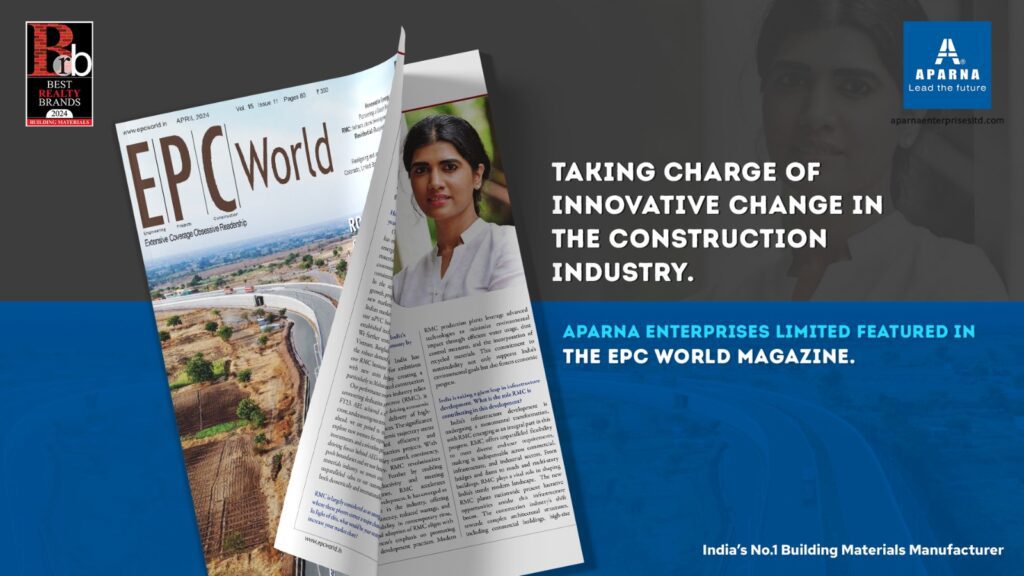
The rise of RMC proves its uprising as not just an industry trend, representing a fundamental shift in India’s construction industry. Steering the industry’s philosophy towards more sustainable, efficient and higher-quality building practices with minimal time taken. Ready Mix Concrete plays a key role in supporting environmental priorities, resulting in less wastage compared to on-site concrete mixing.
In this feature, we take a deep dive to look at the innovations and Aparna Enterprises Limited contribution to the nation, the challenges faced and the strategies being deployed to cement RMC’s place as the bedrock of new India
RMC will be a key contributor in India’s ambitious target of $5 trillion economy by 2025. What is your take on this?
The growing economy of India has generated significant demand for ambitious infrastructure projects, thereby creating a need for robust and sophisticated construction solutions. As the construction industry relies heavily on Ready Mix Concrete (RMC), it emerges as a crucial part for driving economic growth by enabling the delivery of high-quality products and services.
The significance of RMC in India’s economic trajectory stems from its unparalleled efficiency and effectiveness in construction projects. With its emphasis on quality control, consistency, and time efficiency, RMC revolutionizes project execution. Further by enabling heightened productivity and meeting stringent timelines, RMC accelerates infrastructure development. It has emerged as a game-changer in the industry, offering improved consistency, reduced wastage, and enhanced durability.
In contemporary times, the widespread adoption of RMC aligns with the government’s emphasis on promoting sustainable development practices. Modern RMC production plants leverage advanced technologies to minimize environmental impact through efficient water usage, dust-control measures, and the incorporation of recycled materials. This commitment to sustainability not only supports India’s environmental goals but also fosters economic progress.
India is taking a giant leap in infrastructure development. What is the role RMC is contributing in this development?
India’s infrastructure development is undergoing a monumental transformation, with RMC emerging as an integral part in this progress. RMC offers unparalleled flexibility to meet diverse end-user requirements, making it indispensable across commercial, infrastructure, and industrial sectors. From bridges and dams to roads and multi-story buildings, RMC plays a vital role in shaping India’s sturdy modern landscape. The new RMC plants nationwide present lucrative opportunities amidst this infrastructure boom. The construction industry’s shift towards complex architectural structures, including commercial buildings, high-rise driveways, and coastal highways, underscores the soaring demand for high-performance concrete. In order to fulfil these ambitious projects and housing demand, RMC plants have gained significant growth.
Moreover, the expansion of the RMC industry to Tier II and III cities signifies its widespread adoption beyond metro projects. This expansion into smaller urban centers and rural areas highlights the growing demand for RMC products nationwide. RMC’s adaptability, efficiency, and eco-friendliness contribute significantly to India’s infrastructure development, aligning with the country’s ambitious construction goals and broader economic growth objectives.
How has your organization performed in the last three years?
Over the past three years, Aparna Enterprises (AEL) has made remarkable strides in the infrastructure sector, emerging as a leading provider of comprehensive building material solutions. Our commitment to innovation and customer satisfaction has been the reason driving consistent growth across all segments of our operations. In the recent past, AEL has witnessed exponential growth, propelled by strategic expansions and penetrating new markets. Last year, we expanded into the North Indian market, specifically the Delhi NCR region, with our uPVC business brand Okotech, which has swiftly established itself as a prominent player in the industry. We further ventured into South Asian markets such as Vietnam, Bangladesh, Sri Lanka, and Nepal, leveraging the robust demand for Okotech products. Additionally, our RMC business has experienced substantial growth, with new units being established in key regions, particularly in Maharashtra.
Our performance over the past three years reflects our unwavering dedication to excellence and innovation. In FY23, AEL achieved a remarkable revenue of Rs 1,650 crore, underscoring our strong growth trajectory. Looking ahead, we are poised to sustain this momentum and explore new avenues for expansion. Innovation, strategic investments and a relentless pursuit of superiority are the driving forces behind AEL’s success. As we continue to push boundaries and set new benchmarks in the building materials industry, we remain committed to delivering unparalleled value to our customers and stakeholders, both domestically and internationally.
RMC is largely considered as an unorganized market where these players corner a major chunk of revenue. In light of this, what would be your strategy to increase your market share?
In the largely fragmented and unorganized market of RMC, establishing a prominent presence requires a strategic approach focused on quality control, innovation, and collaborative partnerships. We implement a multifaceted strategy which is aimed at delivering superior products and expanding our reach across diverse regions.
The most important focus for us has been prioritizing our product quality and exceptional customer service. We continuously innovate and enhance our product offerings. By introducing new products and improving existing ones, we aim to differentiate ourselves from competitors and attract customers seeking reliable solutions for infrastructure projects. Additionally, collaborating with trusted suppliers enables us to streamline product access and expand our distribution channels, thereby reaching a broader consumer base across various regions.
Furthermore, by acquiring established leaders in the industry or pursuing mergers with compatible entities, we can consolidate resources, broaden our target audience, and enhance overall competitiveness in the market. Amidst the increasing demand for high-quality products in the Indian market, particularly from multinational companies, we remain steadfast in our focus on quality and innovation which enables us to capture larger market share and driving sustained growth.
For the benefit of our readers, please share the challenges RMC manufacturers face while executing realty projects in metros
Execution of real estate projects in metro cities is a formidable challenge for RMC manufacturers. The real estate sector downturn weakened by liquidity constraints impacts demand and revenue streams. In addition, the traffic regulations and congestion on the roads do not allow the delivery of cement, which is very important for maintaining the quality of the product and the timely completion of the project. Another challenge is ensuring a constant supply of raw materials such as aggregates, with logistical limitations and supplier dependencies posing the risk of the disruption of the supply chain.
Additionally, the presence of smaller unorganised scale players in the RMC industry complicates the competitive scenario. Traffic regulations and city-space restrictions pose challenges for establishing commercial plants. These challenges call for the RMC manufacturers to come up with innovative ways such as diversifying the marketing efforts to semi-urban areas and improving the logistic operations. Collaboration with the stakeholders and advocacy for simple regulatory procedures are equally crucial for the smooth operationalisation of realty projects in metro cities.
What are the other challenges faced by RMC manufacturers while commissioning infrastructure projects in India?
Besides the mentioned issues, manufacturers of RMC also face multiple other impediments while deploying infrastructure projects in India. Throughout the whole process, from preparation to transportation and use of RMC, a large number of risks are present and some of them will lead to a lack of consumer confidence and diminished profits unless managed properly. Besides the internal factors, including the incorrect choice of admixture, machine breakdowns, and transportation accidents rank high among the external factors that call for sound management strategies for a streamlined flow of operations and effective completion of the projects.
In addition, factors such as the wrong mix formula, unjustified specifications for quality standards, and the transportation lag time contributed by the road traffic introduce unforeseen inconveniences to infrastructure projects. Furthermore, environmental issues may add up to more complex problems. Adhering to the regulations for the environment and minimising the environmental impact of the production and utilisation of RMC should be prioritised.
Resolving these problems should be done through a solution that consists of risk management techniques, quality control practices, logistical effectiveness, and environmental consciousness so as to achieve the successful outcomes of RMC projects in India.
There is a paucity of skilled manpower in the RMC industry? What are the steps you are taking to increase skill manpower in the RMC sector?
The lack of skilled manpower in the RMC industry is a major problem in its growth and efficiency. Recognising this issue, we have implemented several steps to increase skilled manpower in the RMC sector. We have internal programs where extensive training are provided aimed at giving people the skills and the expertise needed for different positions in the RMC sector.
We equip them with knowledge on concrete technology, quality control, operation of equipment, safety protocols, customer service, etc. Our skill development helps in skill improvement and career development of the workforce .We invest in the training of professionals with the aim of improving the productivity, efficiency, and sustainability of the RMC sector, and in so doing, fuelling its growth and success in the long run.
Your take on the government policies and regulations and the tweaks required to propel the RMC sector
Policies and regulations of the government are integral in determining the evolution and growth of the RMC sector in India. Efforts by the government such as advocating the use of RMC in infrastructure projects and pushing its benefits in smart city missions has greatly helped the industry to grow.
Regarding the RMC sector, more amendments should be made. These include simplifying the regulatory framework in order to promote a friendly business environment for RMC manufacturers, financial and tax incentives to promote the use of RMCs, and improving infrastructure to stimulate construction activities that are the major drivers of demand for RMC.
Furthermore, sustainability, research and technology investment towards increased longevity of RMC, and a continuous supply of high-quality aggregates are critical for the sustainable growth of the product in India. All in all, a coordinated approach among government, industry stakeholders, and regulatory bodies is needed to overcome challenges, implement applicable changes, and take the RMC sector to the next level towards sustainability.
What are your expansion strategies for the fiscal year 2024-25? Are there plans to launch new products or is a Greenfield or Brownfield facility in the offing?
In the fiscal year 2024-25, our expansion strategies are twofold, to strengthen market presence in the North region of India and expand our reach beyond regional confines and actively engage in large and government infrastructure projects. Diversifying our market penetration in North India is a multiple strategic action process.
In line with this, we intend to create a more viable sales and delivery network by placing new sales offices and distribution centers at strategic points across the region. Our reputation will enable us to develop alliances and distribution networks in these regions, ensuring that our products and services cater to the specific needs and preferences of different markets. Along with market expansion attempts, we also aim to be part of government ambitious infrastructure projects.
We will keep on investing in modern production facilities and also upping the efficiency of our current units to remain steadfast and cater the burgeoning demand of the infra sector.
Alteza’s Elegance and Aesthetics Now in Pune
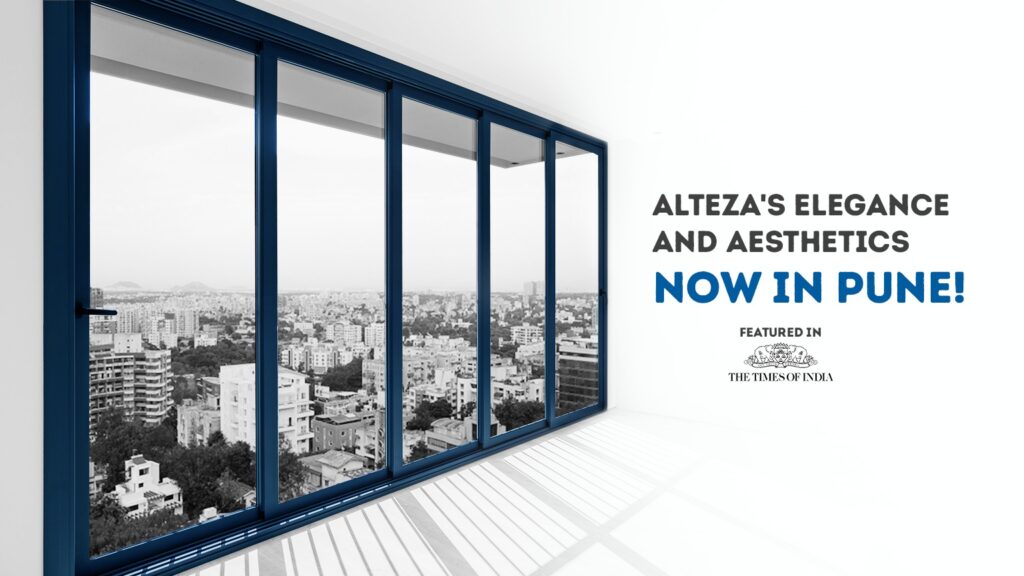
Aparna Enterprises has entered in the Pune market through its B2C aluminium windows and doors brand, Alteza.
The company later plans to expand its reach
across the state, targeting key cities like Nagpur, Kolhapur, Nashik and Aurangabad. In the first year of its operations, it aims to capture 5% market share in the state.
Launched in 2019, the Alteza brand has created revenue of Rs 80 crore and has presence in all southern Indian states.
The company is planning to increase the revenues from the brand to Rs 150 Crore by FY 25 through expansion, and expects it to contribute to 15% of the revenue by FY27.
Aparna Enterprises has reported a topline of Rs 1850 Crore in FY24. The Hyderabad-based Company operates in the construction materials space such as ready-mix concrete, floor and wall tiles, aluminium window and door system, cold roll form products and elegant bath space and kitchens.
Progress with Passion, Ms Aparna Reddy’s Vision
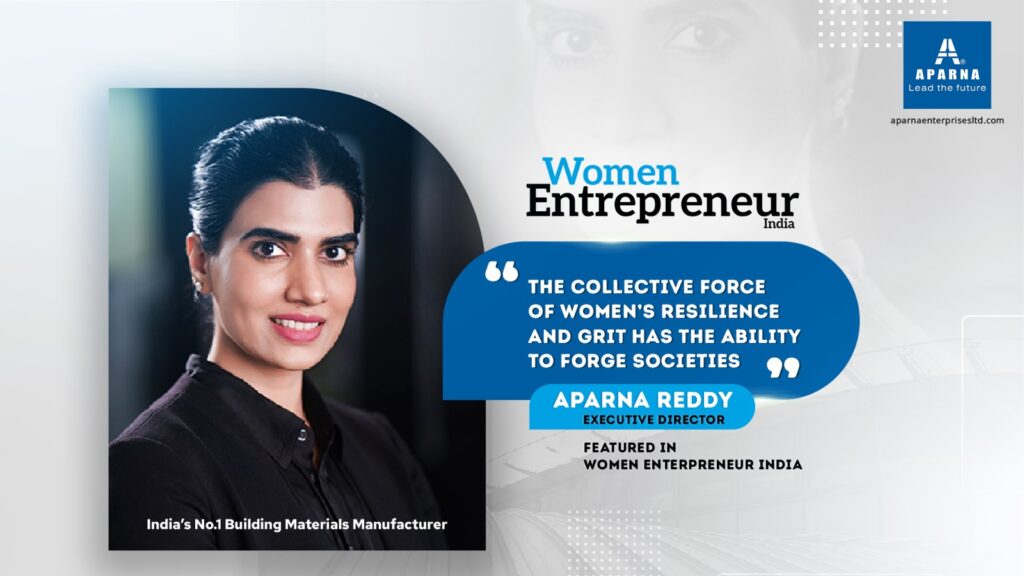
Why is Inclusion Important for businesses?
As a woman leader in the Indian business field, I truly think that an organisation’s diversity and inclusion are not just a moral obligation but a strategic necessity for the business’s success. Diversity contributes to a robust set of viewpoints, experiences, and talents in the team, which enables innovation and creative solutions for emerging problems.
Women, often underrepresented in leadership roles, bring unique insights that contribute to holistic decision-making. Empowerment of women through inclusion enables them to show their best qualities, to overcome gender differences, and to break stereotypes. A diversified workforce not only reflects the rich mosaic of society but also promotes flexibility in a business atmosphere with continuous changes.
On the other hand, inclusive practices not only improve a staff’s morale but also their productivity and commitment. The employees’ willingness to commit more towards the organisation’s prosperity is strengthened when they feel heard and taken into account. In this context, inclusion is a real game-changer when it comes to shifting the dynamic and positioning women for positions of leadership in every industry, with the eventual goal of businesses being run by women, even on the global level.
What steps can be taken to inspire inclusion in the Indian business landscape?
In the realm of building material manufacturing, inspiring inclusion requires a multifaceted approach. Companies can offer mentorship programs, workshops, and courses and train the leaders about the benefits of diverse perspectives, in the workplaces. As an organisation, we can induct women for more technical jobs and train them equally for niche engineering requirements. Once they conquer such techniques we must entrust them with respective responsibilities, with belief and with support, so that they get opportunities to showcase their unique achievements that will inspire others to follow as well.
The business associations and government bodies could shape the process by establishing policies that promote gender equality within business services. This could be done by granting tax breaks or other financial bonuses to business entities that show a clear intention to have women in top leadership positions.
Organisations, especially start-ups, must emphasise on an inclusive culture by offering equal opportunities to women entrepreneurs. Initiatives like establishing funding schemes for women-led startups, organising networking events for women founders, and providing startup incubators exclusively for this group would help to fill the gap. Established female entrepreneurs can also initiate such programs, provide mentorship and outreach, and guide the women wishing to start their own businesses.
By implementing such an approach we will not only promote a wide range of talents but also strengthen the development and vibrancy of the industry.
What’s your message for womenfolk across India, on International Women’s Day?
On this International Women’s Day, I want to send a message of resilience, empowerment, and unity to the incredibly strong women of India. Through this venture together to attain our ambitions and aspirations, let us be one while breaking the barriers and becoming inclusive. Embrace the uniqueness of yours, because they are the source of your significance. The collective force of women’s resilience and grit has the ability to forge societies. Let us keep backing each other up, pushing gender equality, and crafting an atmosphere where every woman achieves as much as she wishes. The power of our unity as women is beyond measure and as such, we look forward to a time in the future when everyone will appreciate and celebrate the immeasurable value women can create in various fields.
A Woman’s Vision Powering Progress
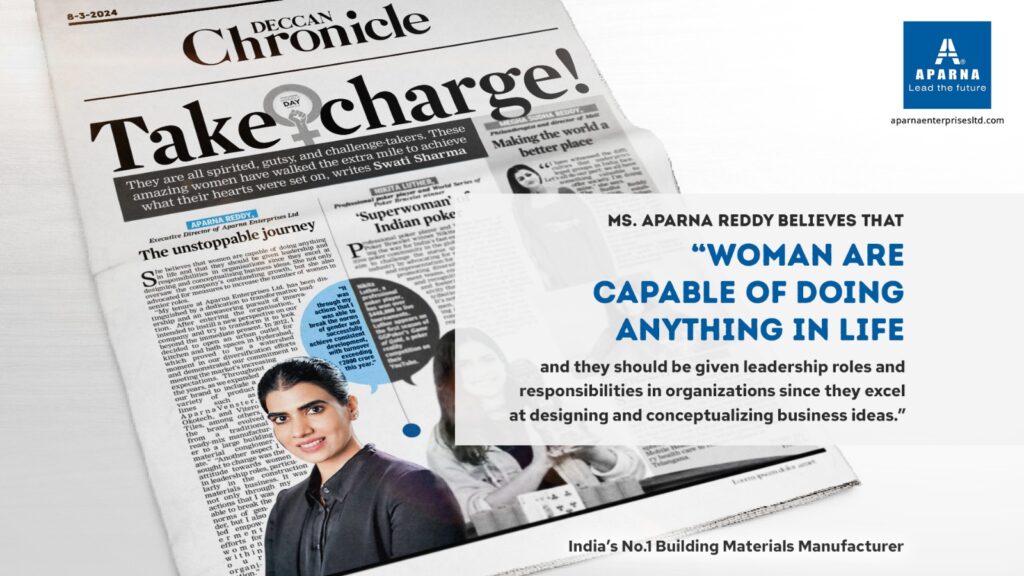
She believes that women are capable of anything in life and they should be given leadership and responsibilities in organisations since they excel at designing and conceptualising business ideas. She not only oversaw the company’s outstanding growth, but she also advocated for measures to increase the number of women in senior roles.
“My tenure at Aparna Enterprises Ltd. has been distinguished by a dedication to transformative leadership and an unwavering pursuit of innovation. After entering the organisation, I intended to instill a new perspective on our company and try to transform it to look beyond the immediate present. In 2012, I decided to open an urban outlet for kitchen and bath spaces in Hyderabad, which proved to be a watershed moment in our diversification efforts and demonstrated our commitment to meeting the market’s increasing expectations. Throughout the years, as we expanded our brand to include a variety of product such as Aparna Venster, Okotech, and Vitero Tiles among others, the brand evolved from a traditional ready-mix manufacturer to a large building material
conglomerate.”
“Another aspect I sought to change was the attitude towards women in leadership roles,
particularly the construction materials business. It was not only through my actions that I was able to break the norms of gen-der, but I also led empowerment efforts for women within our organisation.”
Budget 2024 Expert Call for Reducing The GST Charge On Essential Materials Such As Steel, Cement, Aluminium
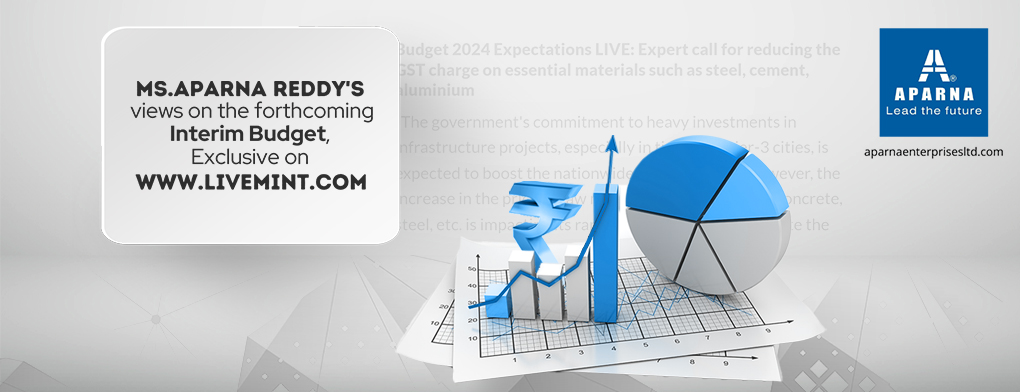
“The government’s commitment to heavy investments in infrastructure projects, especially in tier-2 and tier-3 cities, is expected to boost the nationwide infrastructure. However, the increase in the price of raw materials such as cement, concrete, steel, etc. is impacting its rapid progress. As we anticipate the upcoming budget, it becomes imperative to address these rising costs strategically, ensuring that the national infrastructure development continues at a fast pace and aligns with international standards. Similarly, in the real estate sector, the rise in property prices, attributed to increasing construction material costs and repo rates, has significantly impacted housing demand,” MS. Aparna Reddy, Executive Director, AEL.
“Reducing the GST charge on essential materials such as steel, cement, aluminium and bringing the petroleum products such as Natural Gas, Diesel under GST and bringing petroleum products such as Natural Gas and Diesel under GST will relieve pressure on developers and contractors driving infrastructure growth in full swing. This will propel consumer demand in the real estate segment as well. Moreover, the government should encourage and foster domestic production of building materials that will bolster the self-reliance agenda and generate employment opportunities. A robust domestic production ecosystem will ensure a stable supply chain, ultimately benefiting the entire industry. Further, it is equally imperative to invest in research and development of eco-friendly construction materials and technologies to reduce the environmental impact caused by construction materials. Incentivizing the companies that adhere to eco-friendly norms with favourable policies will drive innovation in this critical area,” MS. Aparna Reddy, Executive Director, AEL.
Amalgam Style & Functionality: Make your Living Spaces Beautifully Personalized Today!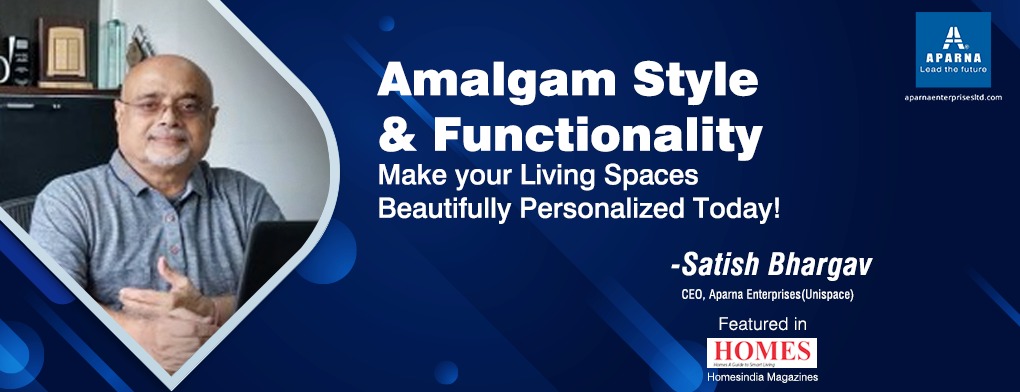
Satish has a vast successful career with 30+years of experience. He started his career with joining Murugappa Group as only non-engineer. Later he joined famous brand Jaquer and expanded its presence in South Asian market, African market and European market. In 2012, he joined Aparna Enterprises limited with high-end solutions of sanitaryware. He propelled the growth of the company with his extraordinary expertise in real estate and home décor sector.
In this vast world, each and every person of any age group has their own tastes, needs and preferences. Same old thing cannot be helpful for every individual all the time. After all, luxury is the ultimate, it will make dream for more. At this advanced age we need certain features to survive and get attuned with this technologically sound environment. For every individual, if luxury is there, the beauty of perfection is there. Now-a-days the structure of family is transforming, so there needs. The personalization is depending on the family and how they want their living spaces to be.
Right proportion of convenience and personalization play the major role in creating exquisite design within limited budget
Personalization is the key of the marketers to attract potential customers. By the virtue of data and technology the personalized marketing has crept into real estate market. After all, in today’s context without personalization nothing can move forward.
Interlinking of Personalized Spaces & Budget
1.Trendy designs should be more functional rather than just being a showpiece. It should have an operational value, deliver elegance, and enhance the beauty of a space wherever it is fixed. Today, we get a wide market to scan and choose materials and we can refer designs online from different designers and can manage our budget-friendly elegance.
2.Personalized spaces are more effective & efficient and sometimes costly or cost-effective. Not everybody can afford luxury brands like Armani, Mercedes, and BMW.
3.Some people who are very much particular about the money they are paying for making their home luxurious and some are very much particular about their budget. So, making a perfect space for the dwellers is very important within the prospective budgets. Designers are playing key role here to convert your living space aesthetically elegant which reflects vibrant at the same time relaxing mode.
Role of Designers & Architect in combining Style & Functionality
1.In today’s context, budget is very important for any individual, and again it varies from person to person depending on their pay-scales and incomes. It is very important to balance functionality and chic & luxurious style in limited space in urban structure.
2.Budget sometimes can rise and go down according to the needs of the individuals. If you need best of the best brands in your homes, lavish and aesthetic design, definitely you need to increase your budget.
3.Starting from fabric, floors, shades and materials everything is designed according to the preferences, where any individual can mix and match products according to their needs. Actually, prior getting into the construction and renovation for your homes, each family needs to discuss their needs and preferences to finalize the respective budget with their designers and architects.
4.Here the designers and architects play crucial role, to guide the individuals in budgeting and cost-controlling while building their dream castle. Convenience plays the major role in creating minimalistic design within limited budget.
Trendy Living Spaces Styles to Fit the New Generations
1.Trendy designs should be more functional rather than just being a showpiece. Firstly, it should have an operational value. Besides, it should deliver elegance and enhance the beauty of a space wherever it is fixed. Today, we get a wide market to scan and choose materials and sometimes, we can refer designs online from different designers and can manage our budget friendly elegance. Not everybody can afford luxury brands like Armani, Mercedes, BMW, and they are very much particular about the money they are paying for making their home luxurious. Experts are there who can guide the homebuyers with perfect matched product according to their budget. Designers are playing key role in converting living space aesthetically elegant which reflects vibrant at the same time delivers relaxing mode.
2.In today’s modern era, people wants their home to look perfect which reflects graceful and chic interior which can charge up their day long exposure to exhaustion at their working place. For a home, living room is the heart of the house. People always want their living room to be designed uniquely. Now-a-days, Classical themed designs are hitting the top spots in the trending list. Apart from that, contemporary abstract aesthetic designs are also high on demand. Sometimes, fusion of the two is also working well with the interiors. Classical designs are little time taking and costly designs which needs expert craftsmen, while contemporary designs are affordable, time saving and easily adoptable.
3.Three important aspects of designs are Floors, Doors and windows, and Fixtures. Choosing right material for the floor is very crucial as it reflects the whole space, proper position and designs of doors and windows is also important as it drives the amount of light coming inside the space, fixtures like bathroom essentials or lightings put an exquisite attractiveness to the space. In modern and contemporary style black and white dominate the color palette, with some faded shades of blue, red, among other prime colors. Then comes the wall shades and curtains which makes the whole design look complete. Each design has its unique characteristics, flavor, finish, and experience, and interior styles.
4.Modern home design uses neutral colors to elevate the sense of functionality. Contemporary home décor is characterized by jute and textured wood, modern curved lightings, curved edged sofa and shining surfaces. Bohemian style is a fusion which includes antique aesthetic décor like metallic items, hand-woven fabrics of bright colors.
Home Interior Boosting Mood, Health & Well-being
1.Thought process of each individual is different and it is quietly based on their moods. When it comes to a home, it should reflect a feeling of love and care besides having elegance. The colors and textures that surround the residents deliver the appropriate vibration which satisfies and uplift the mood and ambience.
2.On the other hand, cluttered spaces and closed spaces without having a little space for air and light to pass can deliver a negative vibe and depress the mood of the resident. In modern and contemporary style, black and white dominate the color palette, with some faded shades of blue, red, among other prime colors.
3.Minimalist Designs uses neutral colors with simple and necessary furniture and fixtures with no extravagant decorations. It boosts the sense of modern functionality and elevate mood of the dweller.
Final Note
To make your dream home budget friendly, uniform thinking should be there in each individuals of the family. They should talk to an expert in the field and take the preferences and comfort upfront and create personalized fusions. But before opting for a fusion we should check whether the elements have co-relation between them, otherwise the whole look will not look complete. Different set of fusion should be adopted for commercial and residential, as purpose of both the building is quite different. This modern era is consistently witnessing a sea change in every sector owing to science and technology. The modernized way of approach is enhancing the hygiene factors and transforming our lifestyle more smart and advanced. For example, AI generated faucets work using AI sensors, remote control curtains, automatic showers do not need a physical touch to work properly. In the upcoming years, more innovation will come and merge with existing technologies like AR, VR, AI, and create a revolution in the field of real estate and interior design.
Ökotech seeks to capture 25% share of uPVC doors and windows in north India
The uPVC segment in India is observing a yearly growth rate of 7%-12%
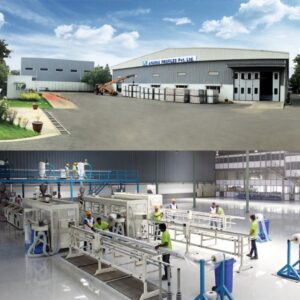
Aparna Enterprises has further expanded into the North Indian market with its uPVC brand, Ökotech, and the company is set to increase its domestic footprint to 200 markets. Ökotech seeks to capture 25% market share of the uPVC doors and windows segment in North India over the next two years.
The uPVC segment in India is observing a yearly growth rate of 7%-12%. In North India, there is a distinctive demand for customisable and environment-friendly uPVC products that can be attributed to a real estate market of largely stand-alone or independent homes. Additionally, there is a growing demand pipeline from high-rise apartments. Aparna Enterprises has effectively tapped into this market with Ökotech that produces uPVC doors and windows as well as profiles.
Aparna Reddy, executive director of Aparna Enterprises, said, “The Indian real estate market is expected to grow more than 12-fold in the next 25 years. This has created a spike in demand for quality building materials that can help develop strong, sustainable and environment-friendly buildings that stand the test of time. We are determined to support the country’s infrastructural and real estate needs.”
Mahesh Choudhary, president and CEO, uPVC Division of Aparna Enterprises, said, “In order to meet the increasing requirements of uPVC doors and windows, we are working towards improving our current production volumes by 70% by the beginning of next year.”
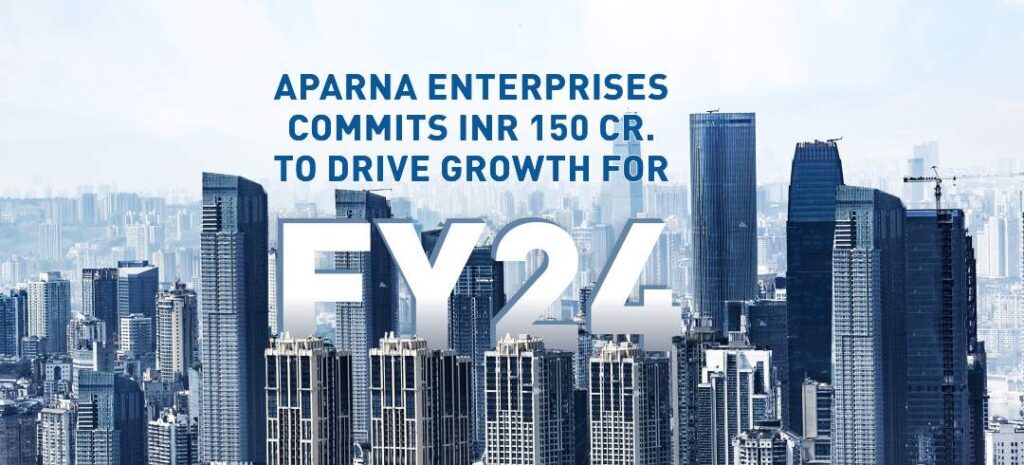
National, August 2023: Aparna Enterprises, India’s fastest growing building materials manufacturer, commits an investment of INR 150 crores in FY24 to proliferate its business and support its expansion to meet the industry’s escalating demand. This strategic commitment is a testament to the company’s unwavering dedication to delivering top-notch products and services that cater to the dynamic infrastructural needs of India. The company plans an outlay of INR 100 crores towards establishing a state-of-the-art uPVC facility at Rudraram, Hyderabad, to increase the monthly production of uPVC profiles by 70% from 700 tonnes to 1,200 tonnes, as well as windows by 150% from 20,000 sq. metres to 50,000 sq. metres. Additionally, another INR 50 crores will be utilised to expand Aparna Enterprises’ tiles, ready-mix concrete (RMC), and aluminium businesses.
The building materials industry is witnessing tremendous growth due to factors such as urbanisation, infrastructure development, and the soaring demand for real estate. It is estimated that the industry will grow by 8-12% over the next five years. As cities expand and modernise, the need for high-quality building materials becomes paramount. Aparna Enterprises, with its diverse product portfolio, including tiles, RMC, uPVC doors and windows, uPVC profiles, and aluminium doors and windows, is well-positioned to meet this demand. The company recognises the potential of these growth opportunities and aims to leverage them to solidify its position in the market.
Commenting on the development, Mr. Ashwin Reddy, Managing Director, Aparna Enterprises Limited said, “With our business footprint spread across the country, we are determined to provide comprehensive solutions to every person and institutions’ diverse infrastructural needs. Our ambitious growth plans are driven by our continuous efforts to offer the best products under the Aparna Enterprises banner. We are confident that our investment in the new uPVC facility and the expansion of our tiles, RMC, and aluminium businesses will enable us to cater to the evolving needs of our customers while strengthening our market presence. We are targeting a revenue of INR 2,100 crore by the end of this financial year.”
In a strategic move to tap into the West market, Aparna Enterprises has launched its RMC business in Mumbai, commencing operations in July 2023. This expansion will allow the company to leverage the growth opportunities in the region and further establish its presence. Additionally, the company plans to strengthen its Alteza business (aluminium doors & windows) by adding new dealers across key locations such as Delhi, Mumbai, Goa, Pune, Kerala, Tamil Nadu, Andhra Pradesh, and Telangana. These initiatives are part of the company’s commitment to expand its reach and capturing the emerging market opportunities.
Aparna Enterprises manufactures and markets its products under Aparna RMC, Vitero Tiles, Aparna Venster uPVC windows and Doors, Ökotech uPVC profiles, Aparna-Craft, Alteza by Aparna-Craft and Aparna Unispace (Luxury Showroom for Leading European Sanitary ware brands).
About Aparna Enterprises Ltd:
Aparna Enterprises Limited (AEL) is a part of the highly successful Aparna Group. Founded in the year 1990, AEL operates through a range of businesses in building-material products, such as RMC (ready-mix concrete), uPVC windows and doors, Floor & Wall tiles, Aluminium window and door systems & Exterior Facades, Cold Roll form products (Steel reinforcements for uPVC windows & doors, Cable trays, False ceiling channels) and Elegant Bath spaces and Kitchens. Associated with several landmark projects for over 30 years, AEL is renowned for setting benchmarks in technology, research, design, and quality. Today, AEL is an acknowledged leader in providing specifiers, contractors, and stakeholders with a range of high-quality products manufactured to the highest standards. AEL can meet any specification criteria while ensuring full compliance with all protocols.
